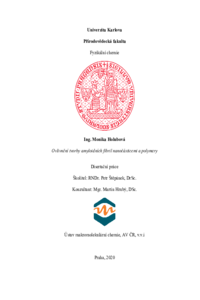Influence of nanoparticles and polymers on the amyloid fibril formation
Ovlivnění tvorby amyloidních fibril nanočásticemi a polymery
dissertation thesis (DEFENDED)

View/
Permanent link
http://hdl.handle.net/20.500.11956/124500Identifiers
Study Information System: 169574
Collections
- Kvalifikační práce [20326]
Author
Advisor
Consultant
Hrubý, Martin
Referee
Štěpánek, Miroslav
Nardin, Corrine
Faculty / Institute
Faculty of Science
Discipline
Physical Chemistry
Department
Department of Physical and Macromolecular Chemistry
Date of defense
29. 1. 2021
Publisher
Univerzita Karlova, Přírodovědecká fakultaLanguage
English
Grade
Pass
Keywords (Czech)
amyloidní fibrily, amyloid beta, lysozym, polysacharidy, uhlíkové nanočásticeKeywords (English)
amyloid fibrils, amyloid beta, lysozyme, polysaccharides, carbon nanoparticlesDisertační práce se zabývá testováním amyloidogenicity různých uhlíkových nanočástic a polymerů. První část dizertace je věnována teoretickému úvodu týkající se amyloidóz, což je skupina nemocí, při kterých dochází k ukládání proteinů v nerozpustné formě amyloidů. Mimo to se teoretická část také zabývá obecným přehledem nanomateriálů a jsou zde také popsány nejdůležitější metody. Vzhledem k tomu, že v práci bylo testováno více druhů materiálů, byla část věnována výsledkům a diskuzi rozdělena na dvě podkapitoly: 1) Uhlíkové nanočástice a formování amyloidních fibril, a 2) Polysacharidy, modifikace glykogenu a formování amyloidních fibril. První podkapitola se zabývá testováním čtyř druhů uhlíkových nanočástic (jednovrstvých uhlíkových nanotrubic (SWNT), fullerenů (C60), uhlíkových kvantových teček (CDs) a nanodiamantů (NDs)). Tyto materiály byly testovány na modelovém systému lysozymu z vaječného bílku (HEWL). Pomocí měření fluorescence a transmisní elektronovou mikroskopií (TEM) byly testované materiály srovnány od nejvíce amyloidogeních částic po nejméně amyloidogenní následujícím způsobem: NDs> control> C60> CDs> SWNT. Druhá podkapitola se věnuje vlivu vybraných polysacharidů (glykogen (GG), mannan (MAN), fytoglykogen (PG)) a modifikací GG. Tyto materiály byly testovány nejen na HEWL, ale i na...
The thesis deals with the testing of amyloidogenicity of various carbon nanoparticles and polymers. The first part of the thesis provides the theoretical background of amyloidoses, a group of diseases in which proteins are stored in the insoluble form of amyloid. In addition, the theoretical part also deals with a general overview of nanomaterials and the most important methods. Several types of nanomaterials were tested within the thesis, so the part Results and Discussion was divided into two subchapters: 1) Carbon nanospecies and amyloid fibril formation, and 2) Polysaccharides, glycogen modifications and amyloid fibril formation. The first subchapter concerns the testing of four types of carbon nanoparticles (single-walled carbon nanotubes (SWNT), fullerenes (C60), carbon quantum dots (CDs) and nanodiamonds (NDs)). These materials were tested on a model system hen egg white lysozyme (HEWL). Using fluorescence measurements and transmission electron microscopy (TEM), the nanoparticles were ranked from the most to the least amyloidogenic as follows: NDs> control> C60> CDs> SWNT. The second subchapter deals with the effect of selected polysaccharides (glycogen (GG), mannan (MAN), phytoglycogen (PG)) and modified GG on amyloid fibril formation. These materials were tested on the HEWL model system,...
